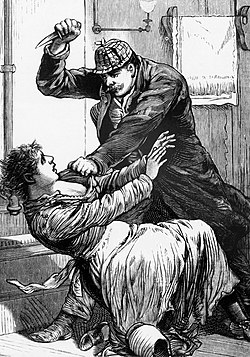Jack the Ripper
| RationalWiki's Chilling Tales of True Crime |
| Articles on illegal behaviour |
| Busted |
Jack the Ripper is the name given to the person responsible for the murder of at least five prostitutes in London in 1888 (and possibly later). This name derives from a letter written in September 1888[1] which is today generally regarded as having been a hoax.
Murders[edit]
Between April 1888 and February 1891, eleven women were murdered in the Whitechapel district of London. While different theories ascribe different murders to the Ripper, five, which occurred between August 31, 1888, and November 9 of that same year, are attributed by most modern commentators to Jack the Ripper. All five of these victims were prostitutes, and all five had their throats cut. In order, they are: Mary Ann Nichols (Friday, August 31), Annie Chapman (Saturday, September 8), Elizabeth Stride (Sunday, September 30), Catharine Eddowes (also September 30), and Mary Jane Kelly (Friday, November 9).[2] All five except Stride displayed mutilation of the abdomen, and Chapman, Eddowes, and Kelly all had organs removed.
Theories[edit]
Contemporary police had several strong suspects, ranging from a barrister who committed suicide shortly after Kelly's murder, to a barber later convicted of other serial murders and executed, to a Jewish bootmaker who one particular constable had personal issues with. No suspect was ever charged with the Whitechapel murders, though they were arrested by the dozen. Beyond the 'official' suspects, though, there have been many theories as to who 'he' was, from a deranged butcher[3] to the son of the Prince of Wales[4] or a painter.[5]
These murders, while by no means the first serial killings, were unique in that they were the first to garner worldwide (well, from the Eurocentrist's perspective) press attention. By accident of timing, they were able to take advantage of a somewhat recent explosion in the circulation numbers of periodicals, which was due in part to decreasing costs. As such, reporting on the subject showed (for nearly the first time) patterns of sensationalism still seen in modern media reports of high-profile crimes, including the publication of four letters allegedly written by the killer, which are now regarded as almost certain hoaxes. Only one letter is believed to have been written by the killer; however, it has been lost.
In addition to being widely covered at the time, the murders have been enshrined in cultural memory, and, as such, attract attention to the present day, leading to a continued stream of research into the matter, of both the academic and nonsensical sort. Some of the more outrageous proposed theories name Prince Albert Victor (George V's older brother, not the Prince Albert of canned fame) as the murderer.[4][note 1] The fact that he was several hundred miles away in Scotland at the time of two of the murders does nothing to sway those who hold this view. Likewise, the ever popular "Freemasonsdidit" claim has been tailored to the Ripper cases, alleging that the mutilations were in accord with penalties laid out in Masonic oaths.[6] That these oaths do not make an actual threat, do not mention harming non-Masons (such as the victims certainly were), and fail to match the mutilations actually observed, which varied from victim to victim anyhow, is likewise no deterrent to such fanciful claims.
DNA tests[edit]
DNA tests have reportedly linked Polish barber Aaron Kosminski with blood and semen stains found on the shawl of one of the victims; the results were first unveiled in 2014 and then published in the Journal of Forensic Sciences in 2019. However, the results are extremely problematic because the shawl's provenance wasn't clear (none of the victim's other clothes were kept); the shawl has been handled by many people including relatives used as comparators; the testing wasn't performed according to proper protocols in a proper DNA lab; the paper describing the results failed to explain methods; and it makes claims about mitochondrial DNA from Kosminski's descendants even though men don't pass on mitocondrial DNA (it's only through the female line).[7][8][9] Still, it's a relief for one man documented in The Onion.[10]
See also[edit]
Want to read this in another language?
|
External links[edit]
Notes[edit]
- ↑ Those versions which describe the murders as covering up his alleged secret marriage also ignore the Royal Marriages Act, which would have rendered it null anyhow.
References[edit]
- ↑ "Where did the name 'Jack the Ripper' come from?" on History House
- ↑ "Jack the Ripper" on BBC History
- ↑ Scott Nelson, "The Butcher's Row Suspect - Was he jack the Ripper?" on Casebook: Jack the Ripper
- ↑ 4.0 4.1 "Prince Albert Victor" on Casebook: Jack the Ripper
- ↑ Fiachra Gibbon , "Does this painting by Walter Sickert reveal the identity of Jack the Ripper?", The Guardian, 8 December 2001
- ↑ "'Jack the Ripper' was Winston Churchill's father" on Henry Makow.com
- ↑ Kristina Killgrove, "Archaeological geneticists call Jack The Ripper DNA study 'unpublishable nonsense'", Forbes, 18 March 2019
- ↑ Dear all, A thread on bad science: The story doing the rounds about the identification of Jack the Ripper via DNA from a shawl is doing the rounds again., Adam Rutherford, Twitter, 18 March 2019
- ↑ Steve Connor, "Jack the Ripper: Scientist who claims to have identified notorious killer has 'made serious DNA error'", The Independent, 19 October 2014
- ↑ "Scotland Yard Frees 163-Year-Old British Man After DNA Evidence Clears Him Of Being Jack The Ripper", The Onion, 19 March 2019
